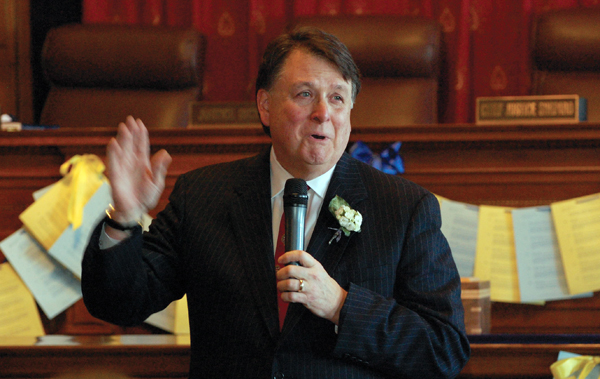
See photos from Chief Justice Shepard’s Retirement Ceremony on Flickr
Editor’s Note: We bid adieu and bon voyage in this issue of Court Times to our leader as he embarks on the next leg of his remarkable life journey and career. We have no adequate words to express our deep gratitude and warm admiration for all he has done in the 25 years that he has served as Indiana’s Chief Justice.
Because he has had such a lasting impact on the trial judges in Indiana, we are printing a tribute to him delivered by the Honorable Charles F. Pratt, Judge, Allen Superior Court, that includes the words and observations of some of these judges. Judge Pratt spoke these words on April 14, 2010 in Indianapolis during the presentation of the American Judicature Society’s Sixth Annual Dwight D. Opperman Award for Judicial Excellence to Chief Justice Randall T. Shepard. An excerpted version of Judge Pratt’s remarks follows.
Ours is a state about which we have much to boast. Yet it often goes against our Hoosier roots to do so. Chief Justice Randall T. Shepard is no exception and as we celebrate the Dwight D. Opperman Award, he will quickly state that his achievement is actually a reflection of Indiana’s judiciary. However, it is clearly because of his leadership that we Indiana Judges have been able to envision a better judiciary for our state.
Included in the qualities required to be recognized with the prestigious Dwight D. Opperman Award is the ability to reinforce collegial ties within the judicial branch. As Indiana trial judges can tell you, the hallmark of the Chief Justice’s gifts is his ability to engage in what can be best characterized as Collegial Leadership—a leadership that recognizes that we are his colleagues, working together to improve our collective and individual service to Indiana citizens.
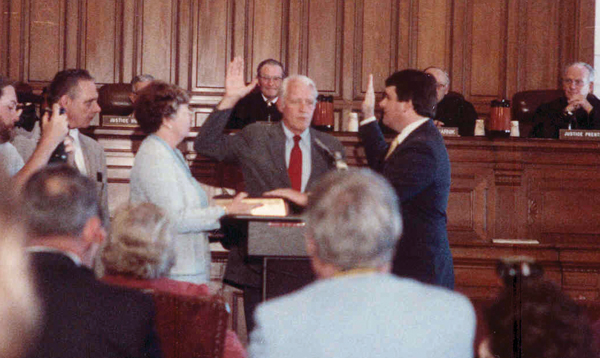
Through his leadership, new reforms and innovations have become the norm for Indiana. These reforms put our state at the forefront in many areas.
In any given year over 300 Indiana judicial officers regularly meet in various committees to consider improvements in our practice. In the midst of this work the Chief Justice encourages us to stretch beyond conventional paradigms. In addition to standing committees, the Chief Justice has sought our input on every innovation and proposed reform. Through his leadership and this collaborative process we can employ Alternative Dispute Resolution, Family Courts, Drug Courts, Truancy Courts, Mental Health Courts, Child Support Guidelines, Protective Orders, pro se services, jury reform, family group decision making practices, dependency facilitation, and technological improvements that include collaboration with other agencies including the state police and the BMV. Just to name a few.
He is indeed a visionary leader who has chosen to walk with us as he leads.
By his collaboration with the other branches of government he has paved the way for us to secure much needed raises and improvements in pension plans. He has ensured that we, the local trial judges, are granted a direct voice with the legislature in matters important to the judiciary. He has never failed to provide Indiana Trial Judges with the needed support when we find ourselves at the precipice of controversial issues.
Possibly the greatest attribute that the Chief Justice brings to his Collegial Leadership is his humility. Today is one such example. In consideration of today’s recognition he e-mailed me:
“…so many of the things for which I was nominated are in fact accomplishments in which trial judges and court staff have played such important roles. I see this award as commending all of us in the Indiana judiciary for the many positive things that have been happening here…”
What he failed to say, however, was that we are only able to embrace reforms because he has empowered us to be so engaged. In addition, as new reforms prosper he is content to allow the local judge to receive the accolades.
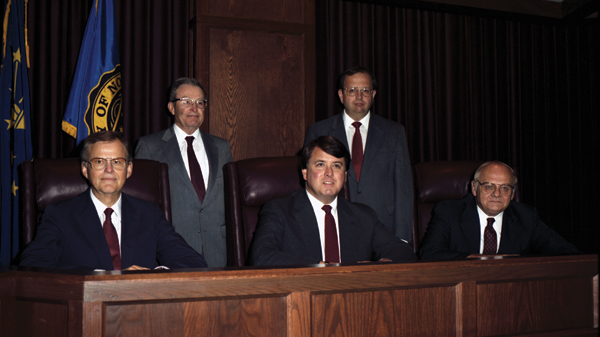
Lest one may sense that my comments are simply my own, allow me to “walk” across Indiana through the comments I received from Indiana’s trial judges:
We begin our journey around Indiana at the northwest corner of our state:
Judge Mary Harper, Porter Circuit Court:
“Under his guidance, we now are able to assist individuals in our day-in and day-out case work. We are no longer seeing just defeat—that is those who re-offend or violate probation. Rather we are now able to congratulate drug-free clients and we are able to watch the rebuilding of families. From the development of Mental Health Courts to Family Courts he has led us from a system of granting and denying to one of developing and helping.”
In nearby Lake County:
Judge Mary Beth Bonaventura, Lake Superior Court—Juvenile Division:
“Chief Justice Shepard is not just reactive to national trends but proactive in exploring and adopting trend setting procedures such as allowing cameras in the court rooms of juvenile courts for ground breaking projects: allowing young people and parents to witness the results of poor choices and behaviors as it relates to juvenile delinquency and child abuse and neglect.”
Moving east across the state to Northeast Indiana:
Judge Fran Gull, Allen Superior Court:
“Indiana is leading the country in jury reform as a direct result of the Chief Justice’s leadership in examining jury trials across the state and the adoption of new jury rules.”
A few miles south of Allen County we enter Adams County:
Judge Fred Schurger, Adams Circuit Court:
“The Chief Justice has demonstrated himself to be pro-judge. I am amazed by his ability to discern trends that are coming and to correctly determine where Indiana should be within those trends.”
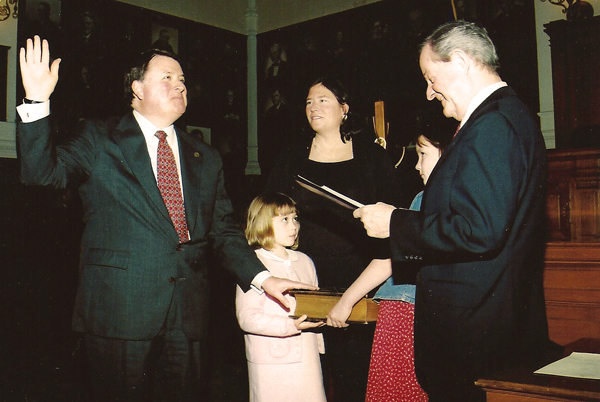
Travelling to Central Indiana:
Judge Steven David, Boone Circuit Court (now Indiana Supreme Court Justice Steven David):
One of the Chief Justice’s early State of the Judiciary addresses profoundly influenced Judge Steve David:
“The Chief Justice encouraged us to step out from behind the bench, to have an impact as a community player and to take leadership risks for the benefit of the people we are elected to serve. His call to duty was not empty as he provided us with continued support in our steps to shift the paradigm of our office.”
And then to neighboring Indianapolis:
Judge Tanya Pratt, Marion Superior Court (now Federal Court Judge Tanya Pratt, United States District Court, Southern District of Indiana):
“At the urging of Chief Justice Shepard, the State of Indiana launched an ambitious effort to increase the number of minority, low-income and non-traditional students in Indiana’s law schools. The Indiana Conference for Legal Education for Opportunity (ICLEO) has changed the face of the Indiana legal community for over 11 years. Our Chief Justice has always encouraged and promoted diversity within the Indiana Judiciary. He has been extremely supportive of my career and offers wisdom, guidance and professional support to the judges who serve in the Indiana State judiciary.”
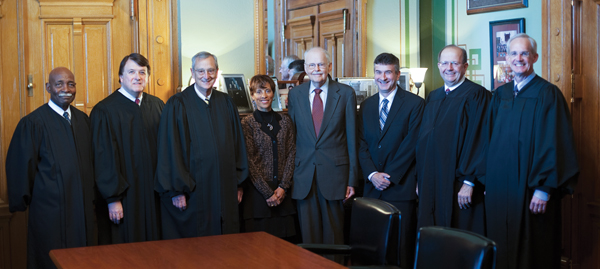
Moving to the Southeast:
Judge James Humphrey, Seventh Judicial Circuit, Dearborn and Ohio Counties:
“Justice Shepard understands what it means to be a trial judge. He has given us the tools to make the process work and the discretion to get the cases tried.”
Judge Roger Duvall, Scott Circuit Court:
“The Chief Justice has made tremendous efforts to make new judges feel welcome and comfortable within the Judges Association. The services he has made available to new judges are extraordinary. As a personal example of that support I am grateful to recall a New Years Eve several years ago. The Chief Justice considered it a priority to brave a winter snow storm as he travelled to Scott County to swear in myself, another judge, and the prosecutor.”
We continue our travel to Southern Indiana:
Judge Vicki Carmichael, Clark Superior Court No. 1:
“The Chief Justice is one of those rare individuals who remembers a person’s name and knows something about them. He always has a comment for new judges and young judges. Regardless of our status within the judiciary, he has always made a point to treat everyone with respect and fairness. As a result, our profession has been enhanced.”
We travel westward across to the central area:
Judge Frances Hill, Monroe Circuit Court, Division 6:
“In 1997, Chief Justice Randall Shepard said in his State of the Judiciary that ‘a family court is a place where you deal with the whole family in a single courtroom regardless of the label.’ From that day forth, the Chief Justice has gently, but with dogged determination, advocated for innovative ways to serve our families and children in the court system. His imperative that we should always strive to better meet the needs of the people we serve, is the mark of excellence that he has stamped on the Indiana judiciary, and the yard stick I use to measure my own efforts as a Judge. I am proud and grateful that he has set the bar so high for each one of us.”
Then we go to Indiana’s southern tip—a place known well to Justice Shepard:
Judge Brett Niemeyer, Vanderburgh Superior Court:
“We’re proud he’s from Evansville. He’s made the state and his home town proud.”
Back up along the western border to the central western area:
Judge Susan Henderson, Fountain County Circuit Court:
“Over the years Chief Justice Randall Shepard has lead by example. He sets expectations for us and encourages creative thinking to prepare for problems that are yet only on the horizon. He recognizes there is no one-size-fits-all and supports innovative programs that may become models for courts across the State.”
Judge John Rader, Warren Circuit Court:
“When I meet with judges from other states and discuss the resources we have available, they are amazed. The breadth of support that we have, thanks to the Chief Justice’s leadership, range from extraordinary judicial education to services that include judicial balance and the judicial assistance program—all of which work to help us do our jobs better. We are the envy of other state judiciaries.”
We end our tour in Indianapolis:
In acknowledging that the employees of the “Supreme Court Enterprises” are proud to be on his team, Executive Director Lilia Judson wrote:
“When Chief Justice Shepard took the helm, his goal was to bring the Indiana judiciary to a place where other states would ask: “what does Indiana say and what has Indiana done?” Under his leadership, Indiana courts have reached and surpassed this goal. From an administrative perspective, Chief Justice Shepard’s visionary leadership has empowered our staff and the trial courts to implement innovative ways to deal with the ever more challenging problems facing our courts. We are constantly improving the delivery of justice in Indiana because he never stops thinking about how we can do better. At the same time, his legal acumen and scholarship have brought a new level of respect and recognition for Indiana jurisprudence.”
Jane Siegel, Executive Director of the Judicial Center adds:
“In addition to delivering his vision, the Chief Justice ensures that we in the Supreme Court family are given the support we need to achieve these goals.”
This award recognizes, and these testimonials clearly demonstrate, that we are uniquely blessed as a judiciary to have a visionary leader at the helm. As a result, we are better judges and the people we are called to serve are the beneficiaries.
As we encounter the future, and the challenges it brings to our profession, we can be assured that we will have a voice in the required resolutions and we can be further assured that in our Chief Justice, we will have a leader who listens as a colleague.
Chief Justice Shepard, on behalf of the Indiana Trial Judges, we thank you and extend our heartfelt congratulations.
The reflections from Judge Pratt and the other trial judges represent just a small sampling of the deep regard in which the Chief Justice is held throughout Indiana.